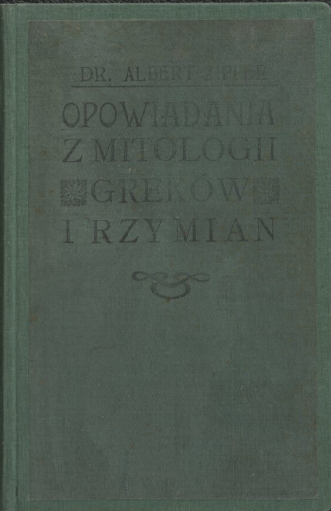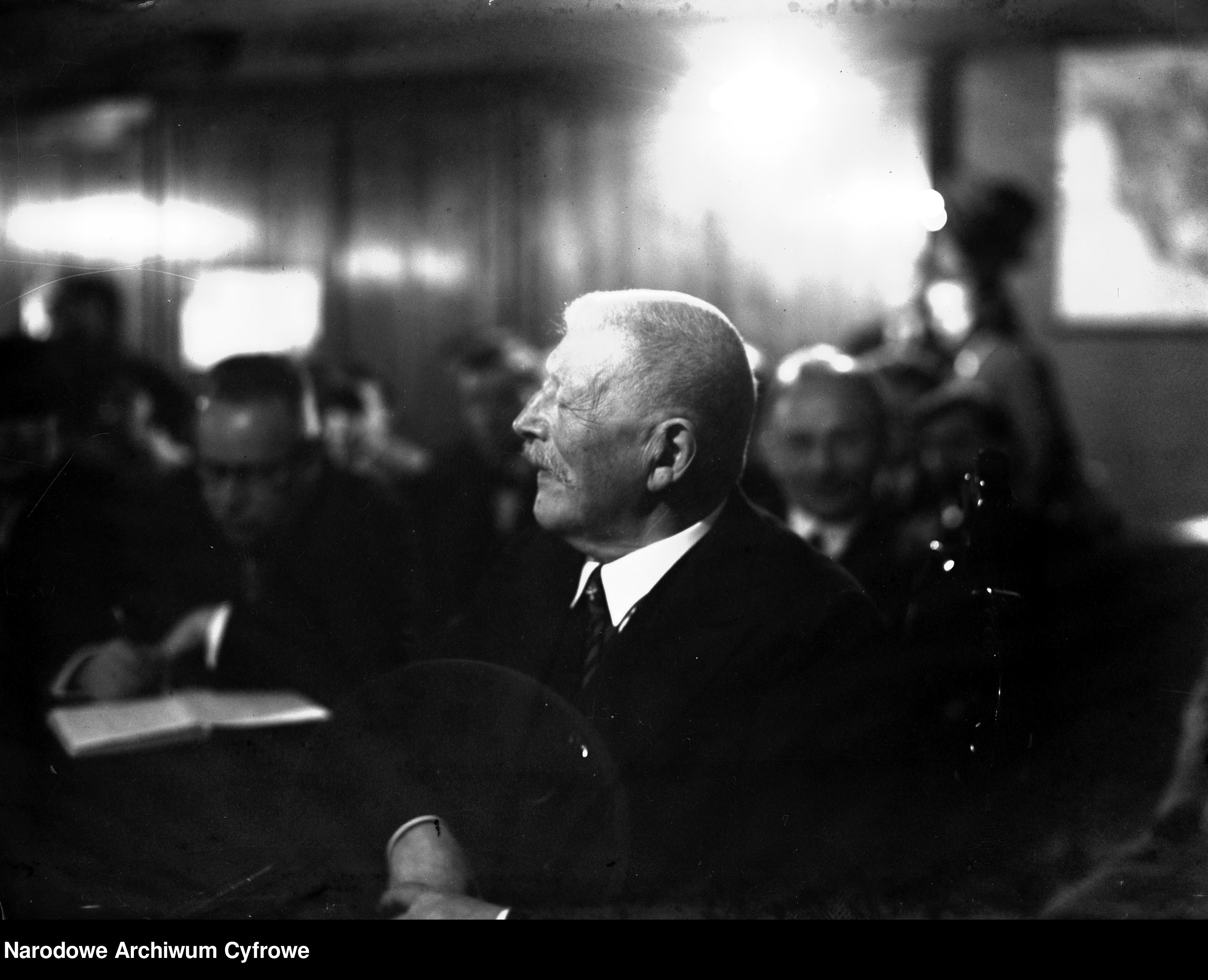Title of the work
Country of the First Edition
Country/countries of popularity
Original Language
First Edition Date
First Edition Details
Albert Zipper, Opowiadania z mitologii Greków i Rzymian dla użytku młodzieży. Lwów: Nakładem Księgarni J. Leona Pordesa, 1886, 216 pp.
ISBN
Available Onllne
Albert Zipper, Opowiadania z mitologii Greków i Rzymian dla użytku młodzieży, Lwów: Zakład Narodowy im. Ossolińskich, 1897, 178 pp. (accessed: September 27, 2021).
Genre
Adaptation of classical texts*
Mythologies
Myths
Target Audience
Crossover (school children, teenagers, young adults)
Cover

Cover in public domain, source: Biblioteka Narodowa.
Author of the Entry:
Summary: Maryana Shan, University of Warsaw, vespertime@ukr.net
Analysis: Marta Pszczolińska, University of Warsaw, m.pszczolinska@al.uw.edu.pl
Peer-reviewer of the Entry:
Katarzyna Marciniak, University of Warsaw, kamar@al.uw.edu.pl
Elżbieta Olechowska, University of Warsaw, elzbieta.olechowska@gmail.com

Retrieved from Narodowe Archiwum Cyfrowe (accessed: December 17, 2021).
Albert Zipper
, 1855 - 1936
(Author)
Albert Zipper, born in Lwów, was a writer, Germanist, translator, poet, and lexicographer. An alumnus of Vienna University (Faculty of Philosophy) – Doctor of Philosophy; high school teacher (Zofia Strzałkowska High School in Lvov, Franz Joseph High School in Drohobycz), Instructor (German language and literature) at the Lvov Polytechnic. Co-author of Dokładny słownik języka polskiego i niemieckiego [The Exact Dictionary of the Polish and German Language], 1879; author of Siedem cudów świata i podróż do Olimpii. Opowiadanie ze starożytności [Seven Wonders of the World and a Trip to Olympia. A Tale from Antiquity], 1886; Cesarz i król Franciszek Józef I [Emperor and King Franz Joseph I], 1888; Mitologia Greków i Rzymian i najważniejsze wiadomości o mitologii Indów, Egipcyan, Babilończyków, Fenicyan, Persów, Celtów, Germanów i Słowian [Greek and Roman Mythology and the Most Important Information about the Mythologies of Indians, Egyptians, Babylonians, Phoenicians, Persians, Celts, Germans and Slaves], 1898, and several other collections of Greek and Roman myths for young readers in wide usage before the publication of Jan Parandowski’s Mitologia. Wierzenia i podania Greków i Rzymian [Mythology. Beliefs and Legends of the Greeks and Romans], 1924 (links accessed: December 17, 2021).
Source:
"Zipper Albert", in Constantin von Wurzbach, Biographisches Lexikon des Kaiserthums Oesterreich, vol. 60, Wien: Hof– und Staatsdruckerei, 1881, 172– 173 (accessed: September 27, 2021).
Bio prepared by Maryana Shan, University of Warsaw, vespertime@ukr.net
Summary
Based on: Katarzyna Marciniak, Elżbieta Olechowska, Joanna Kłos, Michał Kucharski (eds.), Polish Literature for Children & Young Adults Inspired by Classical Antiquity: A Catalogue, Faculty of “Artes Liberales”, Warsaw: University of Warsaw, 2013, 444 pp.
This collection includes Greek and Roman myths about the beginning of the world, gods, their characters and relations, heroes and their deeds. The book presents many theological aspects – in the introduction, the author explains that the world was created by God. However, ancient people did not possess such knowledge and tried to explain natural phenomena and events, thus creating a mythology. It is important to study mythology: it is a key to understanding beauty and art. The author mentions that Romans borrowed from Greek mythology. He presents analogies between these two cultural traditions, and the similarities and differences between Greek and Roman gods. Albert Zipper created a very thought-provoking work – the book is especially valuable because it treats representations of myths in art, their interpretations and adaptations; the writer provides names of the museums where such art is exhibited, adds international cultural context and historical comments showing the place of the myth in the world’s heritage. His narration is supported by facts and historical references, allowing the reader to identify the cultural and historical space.
Analysis
The book can be considered a supplementary textbook or companion to classical mythology for school children in those times.
The author starts with a short introduction presenting his generation’s traditional Christian view* juxtaposed with ancient polytheism and its plethora of myths containing the genealogy of gods, their deeds and fortunes. Zipper considers the Greeks to be great creators of mythology with a rich imagination and a significant impact on the development of literature and art (whereas Romans are only borrowers). He states that ignorance of Greek mythology makes it impossible to read and understand literature and art. For that reason, the book can help school children to learn about this vital part of their cultural heritage. This educational goal is evident throughout the entire text.
The book is divided into over 60 short chapters, facilitating reading, retaining and identifying a specific myth if needed. Traditional myths are presented in “chronological” order, starting with the oldest deities emerging from Chaos – Ouranos and Gaea and their progeny, the Titans. While presenting the Olympians, the author includes their Roman counterparts at the end of a story about a Greek deity or mentions the Roman name in brackets. The secondary myths related to Olympian gods appear as additional stories. For example, having presented Artemis, the author narrates the myth of Actaeon, the story of Herostratus and the myth of Niobe. Curiously, all the water deities, including Poseidon, are presented together. Similarly, Pluto is included in the chapter about the Underworld. Having discussed the main gods, Zipper starts chapters about mortals, starting with the creation of man, the Ages of Man and the deluge at the end of the Bronze Age and the beginning of the Heroic era. This way, the author follows the “chronological” order and presents myths of demigod-heroes and other well-known myths concerning men of the Heroic Age, concluding with the Trojan war, Odysseus’ and Aeneas’ journeys.
The book describes individual gods, heroes, or mythical protagonists and their affairs. As far as gods are concerned, their cult, institutions (e.g., oracles, games) or festivals are included. Most chapters conclude with an ancient image of the character portrayed in art. This included illustrations: drawings or photographs of ancient objects, primarily works of art or other museum exhibits from various places, such as Pompei, Pergamon, Musei Capitolini, Musei Vaticani, and others. All of the illustrations have titles and are discussed in the main text. Similarly, sources are provided in footnotes (for instance, the chapter about Olympia and the games is based mainly on Curtius**). When a text reference is made for a second time, the number of the page of the first mention is provided to make it easier for the reader who may wish to refresh their memory. The author includes plenty of explanatory material about mythology and ancient culture, architecture, history, and archaeological discoveries to meet his educational goal. The book seems to be designed to work in tandem with the Latin language curriculum; some fragments are selected to correspond to the readings provided in the Latin lessons. Despite its elegant literary style, the informative language remains accessible; it is well-suited to school children.
What sparks particular interest is the modifications made with young readers in mind. Although the book is not aimed at very young children, we notice some omissions and/or interventions into the fabric of myths. First, the Christian point of view is used (as announced in the preface) to present the pagan beliefs of the ancients adequately. Thus, an element of critical assessment is introduced and the interpretation and/or omission of “inconvenient” aspects. An example of critical assessment is provided through comments about flamen Dialis, a religious function “subject to many bizarre rules” (p. 25), which highlights the dissimilarity between a Roman and a Christian priest. Another critical comment denounces Clytemnestra’s relation with Aegisthus, called a “sinful couple” (p. 159); Neoptolemus is described as “savage” when he kills Priam at Zeus’ altar.
Explanations are provided when it was impossible to remove the issues considered immoral. A good example is glossing over incestuous relationships; Ouranos is not born by Gaea, they both emerge from Chaos and have legitimate progeny. Similarly, Rhea is called the wife; the fact that she is also Cronus’ sister is not mentioned. In many cases, the name of the father or the mother is omitted (Persephone is the daughter of Demeter, Dionysus is from Thebes, Hermes only has “a mother” who remains nameless). In the case of Zeus and Hera, such an omission is not possible, as they were already described as Cronus’ children. Not to leave this detail without a comment, Zipper writes about marriages between siblings: “it did indeed happen among some ancient nations; anyway, mythology consists of fantastic legends, where imagination was not limited by reality. She [Hera] was considered the sister and wife of Zeus” (p. 26).
So in order not to cross the line, sexual allusions are non-existent (Aphrodite is born from the sea, Phaedra wants to be Hippolytus’ wife, Nessus “dishonours” Heracles’ wife, Heracles does not have an affair with Iole, but was rumoured to have planned on marrying her. Minos is an esteemed monarch whose subjects have to suffer the Minotaur, a monster who just “appeared on the island.”). Extramarital affairs between gods and mortals are not discussed at all; even the wrath of Achilles is caused by “an argument” with Agamemnon. Violence is also sanitized to avoid displaying cruelty to sensitive school children, and details are always omitted when it is described. Thus, Cronus “deposes” his father (p. 3) and later, “according to another version, [is] reconciled with Zeus and rules the Elysian Islands” (p. 4), Athena “jumps out” of Zeus’ head (no backstory of the union with Metis, no description of opening Zeus’ head), the Niobids are just “shot” (no details given), Helle does not drown in the sea but marries a sea god; Bellerophon does not accidentally kill his brother or reject Antheia’s amorous advances. Similarly, Heracles’ myth omits all of his unintentional killings to make the hero flawless so as not to clash with his choice at the crossroad. The only case where abominable deeds are highlighted is the myth of Medea, who is presented explicitly as a witch and the worst possible villain.
In conclusion, Zipper’s book can be considered a key example of the late 19th-century manuals of mythology written with a clear educational goal in mind. The adjustment made for the age of school readers is noticeable on many levels: language, composition, selection of myths and their secondary plots, and the volume and diversity of provided information.
* "… wierzymy dziś, że […] słowem wszechświat cały – są dziełem jedynego Boga, który je stworzył i opiekuje się niemi. Cóż myśleli o tem ludzie w owych czasach, kiedy o jednym Bogu nie mieli jeszcze wyobrażenia?" (p. 1).
** Ernst Curtius, Olympia: ein Vortrag im wissenschaftlichen Verein zu Berlin, Berlin: Verlag von Wilhelm Hertz, 1852. Available online at Universitätsbibliothek Heidelberg website (accessed: December 1, 2021).
Further Reading
Doktor Albert Zipper, Złoczów: W. Zukerkandel, [s.n., non ante 1908] (accessed: December 3, 2021).
Konopka, Maria, “Antykwariat J. Leona Pordesa w księgarsko-wydawniczym krajobrazie Lwowa drugiej połowy XIX wieku” in Halina Kosętka, ed., Kraków – Lwów: książki, czasopisma, biblioteki. T. 7, Kraków: Wydawnictwo Naukowe Akademii Pedagogicznej, 2005, 103–116.
Rollauer, J., “Z żałobnej karty. Ś. P. Dr. Albert Zipper”, Przegląd pedagogiczny 13 (1936): 222. (accessed: December 3, 2021).
Zipper, Albert, Mitologia Greków i Rzymian dla młodzieży, Lwów: Nakładem księgarni Leona Pordesa, 1885. Online edition 1886. (accessed: December 3, 2021).
"Zipper Albert", in Constantin von Wurzbach, Biographisches Lexikon des Kaiserthums Oesterreich, vol. 60, Wien: Hof– und Staatsdruckerei, 1881, 172–173 (accessed: December 3, 2021).
Addenda
The German version of the title quoted by an Austrian biographical lexicon (see Further Reading): Götterlehre der Griechen und Römer für die Jugend shows similarity to the book by Friedrich David Nicolas: Götterlehre der Griechen und Römer: für die reifere weibliche Jugend, 1886. It can be assumed that both had similar educational goals, considered vital in the late 19th century.


